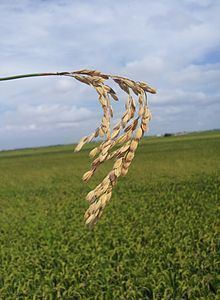Kingdom Fungi Rank Genus | ||
 | ||
Similar Magnaporthe, Drechslera, Cochliobolus miyabeanus, Helminthosporium, Rhizoctonia solani | ||
Pyricularia oryzae fungi kingdom
Pyricularia is a genus of fungi and was established by Saccardo in 1880.
Contents
The polyphyletic nature of Pyricularia has been resolved and species of Pyricularia s. str. were shown to belong to a monophyletic clade (including Pyricularia grisea isolates), defining the family Pyriculariaceae.
Etymology
The genus Pyricularia is named after the pyriform (pear-shaped) shape of its conidia.
Pathogenicity
The Pyricularia genus includes species that are pathogenic on a wide range of monocot plants. For example, Pyricularia oryzae (sexual morph Magnaporthe oryzae), the causal agent of the rice blast disease, is one of the most widely distributed diseases of rice, and is highly destructive leading to up to 30% yield loss worldwide. Pyricularia oryzae isolates from rice are mostly host-specific and infect only few host plants beside rice (barley and Lolium). Pyricularia oryzae isolates from other host plants such as Eleusine, Setaria and Triticum are also host-specific, and unable to infect rice. The closely related species P. oryzae and Pyricularia grisea are indistinguishable in morphology of conidium, perithecium and ascopore. Pyricularia grisea isolates from Digitaria were shown to form a distinct clade by phylogenetic analysis and infect crabgrass (Digitaria), but not other hosts. However, some P. oryzae isolates from rice and other grasses and some P. grisea isolates from crabgrass were described to show cross-infectivity on crabgrass and rice, respectively.
Sexual morphs
Sexual morphs were reported for P. grisea and P. oryzae. The genus Pyricularia comprises several other species for which the sexual morph has not yet been discovered.
Taxonomy
Conidia are solitary, pyriform to obclavate, narrowed toward tip, rounded at the base, 2-septate, hyaline to pale brown, with a distinct basal hilum, sometimes with marginal frill.
Type species: Pyricularia grisea Sacc., Michelia 2(no. 6): 20. 1880.
Family
Species of Pyricularia s. str. belong to a monophyletic clade that includes P. oryzae/P. grisea isolates, and was defined as Pyriculariaceae. Pyriculariaceae is sister to the Ophioceraceae, representing two novel families. These clades are clearly distinct from species belonging to the Gaeumannomyces pro parte/Magnaporthiopsis/Nakataea generic complex that are monophyletic and define the Magnaporthaceae family.
